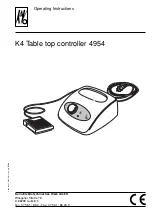
Introduction
Owner’s Manual
7
Introduction
Thank you for choosing the Yamaha
Rio3224-D2/Rio1608-D2 I/O Rack. This product is a
Dante-compatible I/O rack for use in a mixing system. The
Rio3224-D2 is an I/O rack featuring 32 channels of analog
input, 16 channels of analog output, and 8 channels of
AES/EBU output. The Rio1608-D2 is an I/O rack featuring
16 channels of analog input and 8 channels of analog
output. This manual explains the settings and
troubleshooting that a mixing engineer or operator will
perform when setting up or preparing the mixing system.
In order to take full advantage of this product’s
functionality, be sure to read this owner’s manual before
use. After reading the manual, keep it for future reference.
NOTE
•
Where specifications for the Rio3224-D2 differ from the
Rio1608-D2, this manual places specifications that apply
only to the Rio1608-D2 in curly brackets { } (e.g., [INPUT]
connectors 1-32 {1-16}).
•
Unless otherwise noted, illustrations for the Rio3224-D2
are used.
•
If certain specifications are common to both the
Rio3224-D2 and Rio1608-D2, both units are collectively
called “Rio.”
Features
Long-distance Dante Network Capability
Low-latency, low-jitter audio can be transferred over
distances up to 100 meters* between devices via standard
Ethernet cables using the Dante network protocol. The Rio
can be used as a general-purpose I/O box for the Dante
network. Supported sampling rates are 44.1 kHz, 48 kHz,
88.2 kHz, and 96 kHz.
This unit supports the AES67 standard for audio
networking interoperability, and allows audio connections
via AES67 with various compatible audio networks.
* Maximum practical distance may vary according to the cable used.
Display and Encoder for Improved
Visibility and Operability
The front panel features an organic EL display, an encoder
with switch, and buttons. The internal head amps and
parameters such as HPF can be viewed and controlled
using only the Rio3224-D2/Rio1608-D2 unit itself. The
unit’s internal errors and status are clearly indicated in the
display.
Remotely Controllable Internal Head
Amplifiers
Internal head amp parameters can be remotely controlled
from a compatible device such as the RIVAGE, CL, QL, or
TF series, or from the Windows/Mac computer application
“R Remote.”
Digital Outputs (Rio3224-D2 only)
The Rio3224-D2 features XLR-3-32 type balanced
connectors for AES/EBU format digital audio outputs.
Gain Compensation Function
If the Gain Compensation function of the
Rio3224-D2/Rio1608-D2 is enabled from a supported
device (such as a RIVAGE, CL, or QL series unit), the
subsequent fluctuations in analog gain will be
compensated for by the internal digital gain of the
Rio3224-D2/Rio1608-D2, and the audio signal will be
output to the Dante network at the gain level that was fixed
immediately before the Gain Compensation function was
enabled. This means that, for example, if the same inputs
are shared by FOH and monitor, changing the FOH gain
will not affect the monitor mix balance.
Two Internal Power Supply Units
Duplicate power supplies allow continued operation even
in the unlikely event that one power supply experiences a
problem.
Quietness
Noise-reduction measures for the fans provide greater
silence.
Firmware Updates
This product enables you to update the unit firmware to
improve operations, add functions, and correct possible
malfunctions. The following two types of firmware are
available for the unit.
•
Unit’s firmware
•
Dante module firmware
Details on updating the firmware are available on the
following website:
http://www.yamahaproaudio.com/
For information on updating and setting up the unit, please
refer to the firmware update guide available on the website.
NOTE
When you update Dante firmware on the unit, be sure to
update Dante firmware on other Dante-compatible devices
connected to the Rio.
Содержание Rio1608-D2
Страница 1: ...EN Owner s Manual Keep This Manual For Future Reference AUDIO INTERFACE ...
Страница 32: ...MEMO ...
Страница 33: ...MEMO ...
Страница 34: ......








































